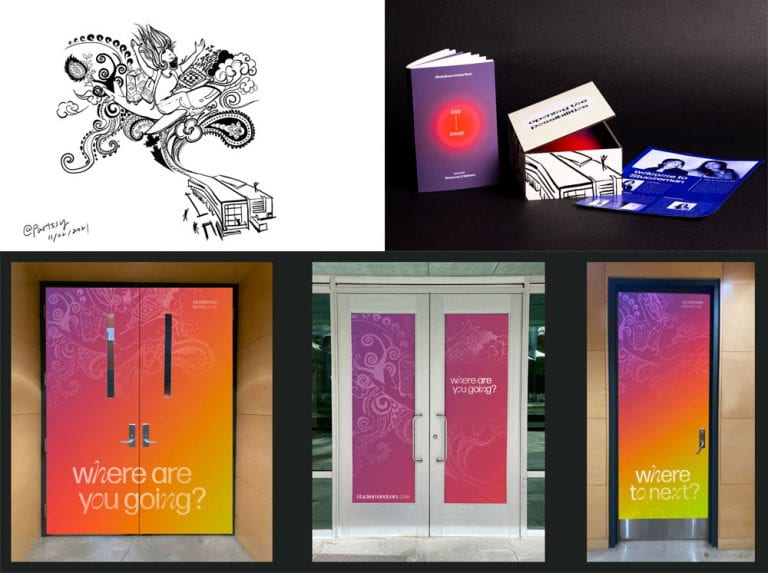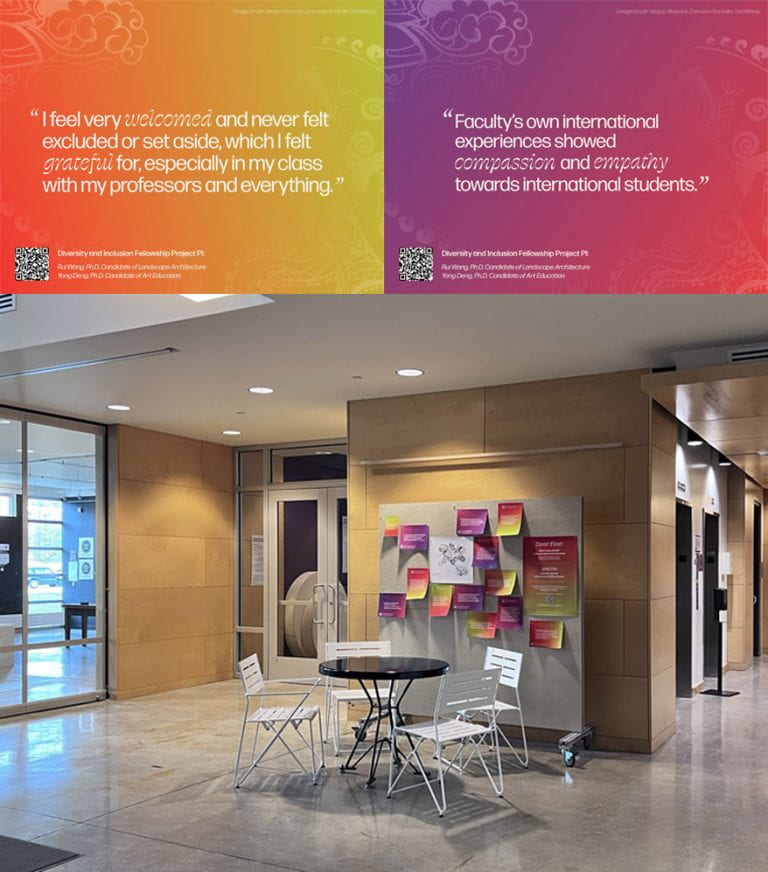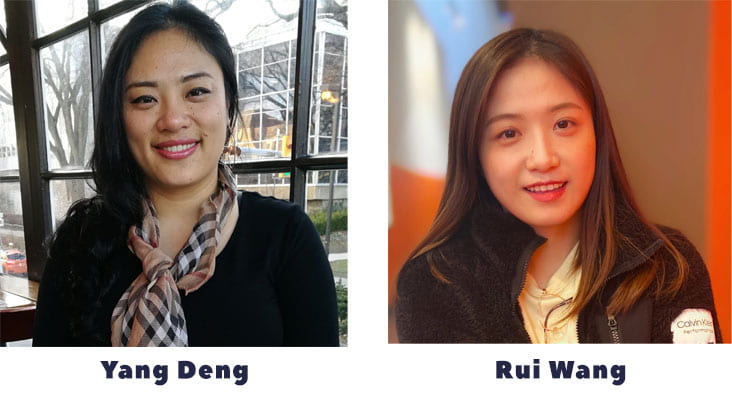Diversity and Inclusion: A Study of International Students’ Experiences at Penn State Stuckeman School
Yang Deng & Rui Wang
In early 2021, Penn State Stuckeman School launched a Diversity and Inclusion Fellowship Program (https://sites.psu.edu/stuckemandifellows). The program called for project proposals and encouraged Stuckeman students to collaborate with people from other programs. We decided to collaborate and create an art+research+service project.
One of the motivations behind our project came from the identified gaps in the fields of U.S. international education, arts education, and Diversity, Equity, and Inclusion (DEI) services. International Education is a well-developed field in the U.S.; however, this field gives little attention to international students’ experiences in the Arts (Visual Arts, Design, Architecture, Performing Arts). Additionally, mainstream studies in arts education also overlook international students’ engagement experiences in arts programs, schools, and universities. Furthermore, within the institutional equity services, international students are not always considered a target group (i.e., LGBTQ, BIPOC, Latinx, AAPI) in higher education despite the structural barriers and discriminations they face (Tavares, 2021).
The gaps in these fields of research and services create a lack of support for international arts students that need to be investigated. Given the opportunity by Stuckeman DI Fellowship Program, we contextualized our investigation within the school, guided by the following three questions.
1) Does Stuckeman School create an inclusive environment for international students?
2) What are the challenges affecting international students’ sense of engagement?
3) How to better promote international student engagement experiences at Stuckeman school?
Our project’s target groups are Stuckeman international undergraduate and graduate students; however, our project engaged both international and domestics community in the Stuckeman (Figure 1).

Art+Research+Service Integrative Project Overviews
Our project established two goals. The first goal is practical: we created a collaborative project model for institutions to integrate visual arts and research to promote international education and DEI. The second goal is more idealistic: we highlighted international students’ experiences in the arts at Stuckeman School – filling the identified gaps in the fields of U.S. international education, DEI institutional services, and arts education. We want to expand our project to serve the College of Arts and Architecture and other institutions to continue advancing meaningful changes.
The project began with a questionnaire survey and semi-structured interviews to elicit international students’ engagement experiences. Based on survey and interview results, we then created a public event involving physical activities and games to promote interaction and social networking among international students and other members at Stuckeman School.
The questionnaire survey was sent to the entire school, and we received 23 international student survey respondents. 13 out of 23 respondents agreed to participate in a follow-up semi-structured interview. Among the interviewed participants, 6 are graduate students, and 7 are undergraduate students; 9 majored in Architecture, 3 in Landscape Architecture, and 1 in Graphic Design.
The survey and interview results revealed that Stuckeman international students were generally satisfied with their engagement experiences at Stuckeman School. However, some less satisfactory aspects emerged, such as financial support, non- U.S. cultural appreciation and appropriation, and cultural integration in the academic curriculum. Unsecured financial conditions, language barriers, and coping with different education systems are the three major challenges. For example, international graduate students preferred the funding mechanism to be more transparent and suggested the school consider adding more non-academic activities to school events besides lectures. International undergraduate students preferred more group work to better engage with domestic students and suggested that more international case studies or cultural appreciation be included in the curriculums.
Additionally, we found that spatial features of the studio environment (e.g., openness), opportunities for teamwork, international background and experiences of the teaching community, and individuals’ student status (e.g., duration of study in the program) are important aspects to influence international students’ engagement.
On April 13, we held a public event “Game Time” outside of the Stuckeman building. The event components include team competition, individual games, prizes, food, and drinks. This social event aims to encourage people in Stuckeman and beyond to get away from the studios and laptops and have fun through games, interactions, and conversations. Overall 40 Stuckeman students and friends participated in these activities. For more details about the project and our public event, please watch our presentation at CPAD (https://youtu.be/rPOBbTQsedg) or visit our project website (https://sites.psu.edu/stuckmaninternationalstudents).
We also collaborated with three graphic design students to assist with the project publicity. We integrated creative drawing and campaign design, serving as a living exhibition of the international student community. For example, some data from the interview are illustrated in a creative drawing. The drawing is also used as patterns for deliverable design and campaign concepts (Figure 3). Representative quotes from interviews were incorporated into flyers disseminated around the Stuckeman and Boland building, and these flyers exhibit international students’ voices (Figure 4).


Afterword
“Everything Started from CPAD Practicum.” – memories from Yang Deng
In Fall 2018, I attended the Center for Pedagogy in Arts & Design (CPAD) Graduate Online Teaching Practicum workshops as part of the online teaching assistant training. The program faculty and experienced graduate student assistants’ presentations were helpful to me as a newbie in online teaching. Two years later, I became an experienced online graduate teaching assistant. On February 3, 2021, I shared my approaches to effective feedback at one of the CPAD practicum training sections with new graduate teaching assistants. After my presentation, one of the new graduate teaching assistants asked me questions about teaching domestic students as an international instructor. That was Rui.
Rui was a Ph.D. Candidate in landscape architecture and studied at Penn State Stuckeman School. During the CPAD online teaching courses, we discussed concerns regarding teaching practice as international graduate teaching assistants, which has brought us to this collaborative and interdisciplinary path. That is how our friendship started as well. C-PAD is a wonderful place for graduate students to improve their teaching and make connections.
